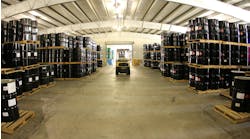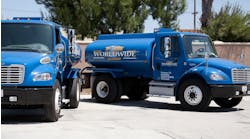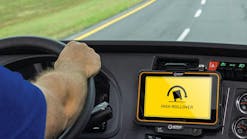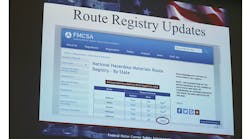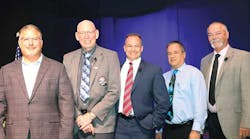Attorney privileges, response immediacy, preventability determinations critical to trucking companies’ survival in a litigious society
It's a call no trucking company wants to receive – their driver’s been in an accident, and somebody is seriously injured or deceased.
But it’s a call every company should be prepared to take, and act upon immediately.
That was the message delivered by attorney Douglas Marcello, a partner with transportation law specialists Marcello & Kivisto, during his Anatomy of an Accident presentation at the annual NTTC Safety & Security Council meeting in Reno Nevada.
“We know about the accident before any (lawyers advertising on TV and billboards),” Marcello said.
“We have the crucial advantage of immediacy, and if we squander that advantage, if we delay, if we balk – if we don’t act immediately and do what we can – we have lost our greatest advantage, because it gives us an opportunity to get the facts, get the information and do the investigation before they even know about the accident.”
Immediacy was the first factor, and a common theme throughout the presentation, with the swiftness of the response key in locking down information, online research and final determinations.
The fundamentals of accident response, he said, are identifying the requisite level of response for the situation, forming the fullest appropriate response and then preparing as if a trial looms within four weeks.
Social media, especially Twitter, is a useful tool in developing the proper reaction, allowing companies to access instant reports from witnesses and even first responders, via related Tweets off police scanners.
Whereas companies were in the dark in the immediate aftermath of an accident in the past, now they can – and should – stay informed.
“It gives us insight into that ‘dark side of the moon’ that we didn’t have before, capitalizing on the technology of today,” Marcello said.
Companies also should immediately begin locking down materials and put into motion a prepared accident response plan. Telemetric and satellite tracking data usually is stored for only up to 30 days, so it needs to be preserved post haste to avoid what’s known as “spoliation of evidence.”
Court remedies for spoliation, which basically is the failure to preserve information, include automatically finding companies liable and telling jurors they can presume the lost data must be incriminating.
“That’s why we want to lock down and preserve this information as soon as possible,” Marcello said.
That’s exactly what Marcello’s firm is doing as soon as they answer the call.
Their response includes looking into the truck driver’s information and hiring an independent adjuster and accident reconstruction team, and the advantage of using them is a big one – attorney-client privilege.
Drivers, in general, should stay quiet, Marcello said, but anything they say to their attorney is protected from discovery, and when their firm hires an adjuster, he or she is working for them, not an insurance company.
“The most important message I give to drivers when I go out to talk to them, in terms of responding to accidents, is to be quiet,” Marcello said. “I wish drivers would say as little at the scene of an accident as they do during their DOT physicals.”
The independent adjuster’s findings, through witness identification, photo documentation and the gathering of information from police, the other driver, and even GPS and surrounding video surveillance, are protected, too, through Attorney Work Product privilege.
Marcello advised going back to social media and online news outlets after deploying the reconstruction team. Sometimes even the comments on a story can generate leads, and the family of someone involved in a fatal accident is likely to quickly remove any unfavorable social media posts.
A photo of someone drinking or smoking, for instance, could mitigate potential damages by establishing a lower life expectancy.
Reconstruction investigators document and photograph the scene and vehicles, using laser scanning and even drones sometimes, allowing them to recreate the accident for jurors, if it’s necessary.
Vehicle inspections always are necessary.
If a DOT inspection is performed at the scene, and they follow CVSA procedures and find no defects, great. But often an independent inspection is required, too, and preserving the vehicle’s ECM data is vital.
Marcello’s firm will go as far as buying a wrecked vehicle from the insurance company or salvage yard in an effort to preserve ECM – and avoid spoliation – but he recommends having a third-party download the data.
And whereas in the past he advised against in-cab cameras, he now advocates their use.
“We get blamed with everything anyhow,” he said. “We might as well have visual evidence to defend ourselves in those cases that aren’t our fault.”
If a suit is filed, where it’s filed, establishing the jurisdiction, can have major implications, and Marcello said it’s often better not to fight a minor traffic ticket if it gives the driver better protection in a civil case.
But the best protection against litigation often is in how the company defines preventability, which is tantamount to establishing negligence. If the definition has a test of “reasonableness,” and the accident is deemed preventable, the company, in effect, is admitting their driver is negligent.
As principal agent, that means the company automatically is liable.
That’s why Marcello recommends a preventability definition based on FMCSA 385.3, which doesn’t contain a test of reasonableness. He also worked with the ATA to align their definition with FMCSA’s.
“We’ve taken reasonableness out of the equation and set up a definition that, by finding your driver be accident preventable, is not an admission of fault by you or negligence by your driver,” Marcello said.
The process and timing of a preventability determination is as important as the initial accident response, requiring careful thought about how much the driver says, who he says it too and what documents are generated.
“When you make your determination, how you gather your facts and how you write up what we did can determine if that is information that is going to be discoverable,” Marcello said.
Another privilege, called Critical Self-Analysis, offers protection in determinations.
“Just like doctor-patient and attorney-client, it is a privilege that keeps that information from even being discovered,” Marcello said.
“The bottom line is, if you follow the guidelines, take a look at what we set up, do it and make it clear in there what you’re doing – write it up as if we’re doing this for a government purpose, we’re doing it ourselves and here are our subjective beliefs – (and) it gives you the best protection you have for protecting any preventability analysis from discovery at the time of court.”
